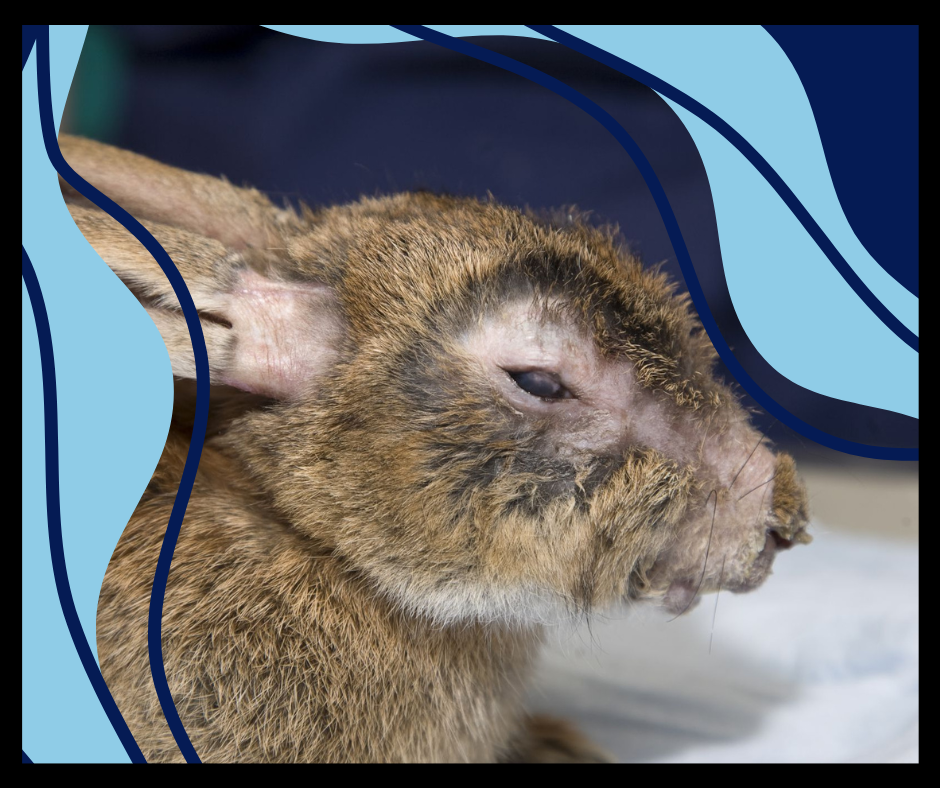Rabbit owners are no strangers to the importance of maintaining their furry friend’s well-being. A significant aspect of this is understanding the various types of rabbit skin infections that can affect rabbits. In this blog post, we’ll discuss how to identify bacterial, fungal, and parasitic rabbit skin problems, their causes, and the preventive measures you can take to keep your rabbit’s skin healthy.
Key Takeaways
-
Identifying skin infections in rabbits is important for their health and well-being.
-
Professional diagnosis, medications, and preventive measures are necessary to treat/prevent rabbit skin problems.
-
A healthy living environment, a nutritious diet, and regular physical activity are essential for supporting rabbit skin health.
Identifying Skin Infections in Your Rabbit

Like any other pet, rabbits can suffer from various skin infections that can lead to discomfort and even serious health complications. Recognizing the signs of these infections and taking necessary precautions are key steps in protecting your pet rabbits and maintaining their rabbit’s skin health.
Recognizing Bacterial Skin Infections
Bacterial skin infections in rabbits can manifest through redness, swelling, and pus-filled lesions on their skin. These infections typically occur when the rabbit’s skin is lacerated or exposed to humid conditions, altering the naturally occurring flora within. Obese rabbits, for instance, may be more susceptible to bacterial infection due to trapped bacteria in their matted fur.
Pyoderma, a medical term referring to bacterial skin infections, is one such example that can affect rabbits.
Signs of Fungal and Parasitic Infestations
Fungal and parasitic infestations can also plague rabbits, causing a variety of symptoms and health issues. One common fungal skin infection is ringworm, which appears as crusted patches of hair loss around the body, often accompanied by itching.
Alongside fungal infections, parasitic infestations like ear mites can cause irritation and discomfort in rabbits, leading to headshaking, ear flapping, and scratching at the rabbit’s ears. Timely recognizing these signs and seeking immediate veterinary assistance is vital for maintaining your rabbit’s well-being.
The Culprits Behind Your Rabbit’s Skin Woes

Various factors can contribute to skin infections in rabbits. Understanding these factors is key to preventing future infections and ensuring your rabbit’s skin remains healthy.
We will examine the environmental and internal health factors contributing to rabbits’ skin infections.
Environmental Factors Affecting Rabbit Skin Health
Poor living conditions, injuries, and grooming issues can all contribute to skin infections in rabbits. Factors that can increase the risk of skin infections and other skin problems in rabbits include:
-
Dusty hay
-
Inadequate hygiene
-
Overcrowding
-
Insufficient diet
Injuries, such as lacerations from sharp objects like wires or cage edges, can also lead to sore skin and skin problems.
Also, incorrect grooming practices can lead to a thinning coat, skin irritations, a heightened risk of flystrike, and walking dandruff.
Internal Health Issues Leading to Skin Problems
Internal health issues, such as obesity and dental disease, can also lead to skin problems in rabbits. Obese rabbits are at an increased risk of skin infections due to impaired grooming ability, difficulty cleaning under skin folds, and impaired skin integrity.
Dental disease can also cause skin conditions, including skin disease, as the associated oral pain and decreased appetite can lead to inadequate grooming, resulting in poor skin health and potential skin infections.
First Aid for Rabbit Skin Infection
Immediate action is needed if you suspect your rabbit has a skin infection. Promptly contact your veterinarian for an appointment and, in the meantime, keep your rabbit separated from others to prevent infection spread. Always comply with any instructions given by your veterinarian for cleaning and treating the affected area.
A well-balanced diet and proper hygiene are also key to supporting your rabbit’s overall health.
Professional Diagnosis: Beyond the Naked Eye

While first aid measures are important, obtaining a professional diagnosis is key for precise treatment and recovery. Veterinarians use various diagnostic tests and procedures like microscopic examination, laboratory tests, and diagnostic imaging to identify the cause of skin infections in rabbits.
For instance, serological immune response tests and fungal culture tests can be utilized to diagnose fungal infections in rabbits. Seeking advice from a veterinarian for an accurate diagnosis and treatment is necessary.
Effective Treatment Strategies for Rabbit Skin Infections
Once a rabbit is diagnosed with a skin infection, appropriate treatment measures should be taken. Treatment options differ based on the type of infection, and adhering to the veterinarian’s advice is important for the best outcome.

Addressing Bacterial and Fungal Infections
Topical and oral medications are available to treat rabbits’ bacterial and fungal skin infections. For bacterial infections, topical antibiotics may be prescribed for application to the affected area. Antifungal creams containing itraconazole, clotrimazole, or miconazole are commonly prescribed for fungal infections.
Oral medications, like enrofloxacin (Baytril) and trimethoprim-sulfamethoxazole, may also be used depending on the specific infection.
Combatting Parasitic Infestations
Parasitic skin infections, such as mites, fleas, and ticks, also require specific treatments. Ivermectin injections and Imidacloprid (Advantage®) are recommended treatments for parasitic skin infections in rabbits. Topical drops effective against parasites can be applied to treat mites in rabbits.
In the case of ear mites, such as rabbit ear mites, professional medical assistance from a veterinarian is necessary to treat the affected ear canal properly, as these mites are different from skin mite infestations.
Preventive Measures to Protect Your Rabbit’s Skin
Prevention is always better than cure. Adopting certain preventive measures can help protect your rabbit from skin infections and contribute to their overall health.

Maintaining a Healthy Living Environment
Creating a clean, safe, and comfortable living space for your rabbit is a key factor in reducing the risk of skin infections. Here are some tips to follow for rabbits housed in such environments:
-
Ensure a cool, non-drafty indoor living area away from direct sunlight
-
Maintain adequate ventilation in enclosed buildings
-
Avoid hard or abrasive surfaces that can cause skin irritation
Following these tips can help keep your rabbit’s skin healthy and prevent infections.
Ensuring the living area remains dry and clean is also key in preventing moisture build-up that can result in infections.
The Role of Diet and Exercise in Skin Health
A balanced diet and regular exercise play a significant role in maintaining your rabbit’s overall health and preventing skin infections. A proper diet, rich in protein, vitamins, and nutrients, is vital for sustaining healthy skin. Grass hay should be an integral part of a rabbit’s diet, along with fresh vegetables and fruit and a limited quantity of pellets.
Additionally, sufficient exercise helps maintain your rabbit’s weight, thus preventing obesity-related skin issues.
Video Credit: @PetsLifeToday
Summary
Understanding the different types of skin infections, their causes, and the preventive measures you can take is crucial for maintaining your rabbit’s skin health. By keeping a clean and comfortable living environment, providing a balanced diet, and ensuring regular exercise, you can protect your rabbit from these conditions and ensure their overall well-being. Remember, a healthy rabbit is a happy rabbit!
Frequently Asked Questions
How do you treat a skin infection in a rabbit?
To treat infection in a rabbit, apply a topical antiseptic cream at least twice a day after cleaning the site and consider an oral/systemic antibiotic for severe cases. Pain medications may be beneficial to soothe soreness.
How do you treat a rabbit’s skin wound?
Rabbits need rest, warmth, good nutrition, and minimal opportunities to contaminate the wound for quick healing. Also, avoid wood flakes that can stick to the wound and ensure the environment is regularly cleaned. You should also ask your veterinarian for an antiseptic solution, such as diluted chlorhexidine, to clean minor wounds.
What is the common skin disease of rabbits?
Cheyletiella infection, also known as rabbit mites or ‘walking dandruff’, is rabbits’ most common skin disease. It is an itchy condition caused by small parasites living on the skin surface and can affect many animals, including rabbits, dogs, and cats.
How can I prevent skin infections in my rabbit’s living environment?
To prevent these infections in your rabbit’s living environment, ensure it is kept clean and dry with adequate ventilation and no harsh surfaces or direct sunlight.
What constitutes a balanced diet for a pet rabbit?
A balanced diet for a pet rabbit should consist of hay, fresh vegetables and fruit, and a limited quantity of pellets for optimal health.
Learn Rabbit Care, Tips, and Tricks!
Learn more about caring for your bunny with us. We’ve got everything from rabbit hutches to essential care tips.
For more information on rabbit care, visit our website: therabbithop.com.
Join our community and become a bunny care expert!
Read More




